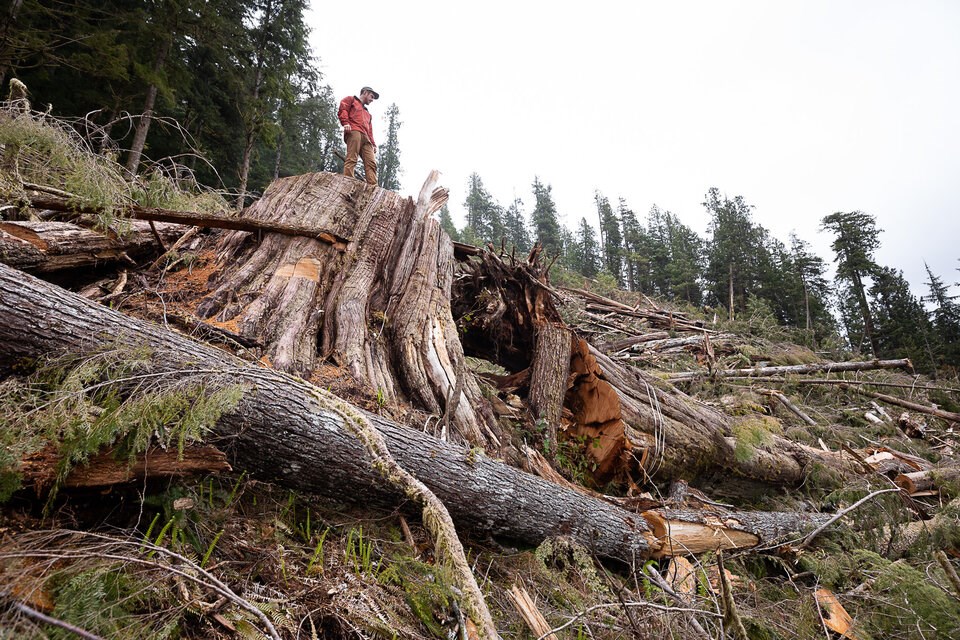The Canadian Centre for Policy Alternatives (CCPA) is accusing Ministry of Forests staff of institutional capture, after receiving leaked data that suggests staff have been watering down recommendations for old growth protection.
If the accusations are true, it may be welcome news to forestry companies and First Nations, like the Huu-ay-aht, that are otherwise facing dwindling harvesting opportunities to old growth protection measures.
The CCPA says it was anonymously leaked mapping data that “reveals a troubling pattern whereby ministry officials appear to be rejecting much of the advice given to the government nearly three years ago by a five-person Technical Advisory Panel.”
The CCPA says Ministry of Forests staff appear to be removing higher value old growth from deferral areas, while adding lower value old growth that isn’t likely to be cut in the first place.
“If this plan by ministry bureaucrats stands, the door could be wide open to logging the last remnant old growth forests, with a heavy bias to logging those forests with the best remaining trees,” CCPA resource policy analyst Ben Parfitt said in a news release.
In response to the Fairy Creek anti-logging blockades on Vancouver Island in 2020 and 2021, the B.C. government tasked an old growth advisory group with recommending protection measures.
A five-person technical advisory panel made recommendations for setting aside areas of old growth from harvesting in 2021 -- up to 2.6 million hectares.
Based on those recommendations, the province established temporary old growth “deferrals”, with more permanent moratoria to be worked out later in consultations with industry and First Nations.
Some First Nations – notably the Huu-ay-aht, who own 35 per cent of Tree Farm Licence 44 on Vancouver Island – opposed some of the old growth deferral proposals.
The original deferrals were temporary, and the government has since been working with stakeholders, including First Nations and industry, to develop more permanent old growth logging exclusions.
After receiving an anonymous letter with a copy of a password-protected file, the CCPA says it asked mapping expert David Leversee to analyze the data, and compare the ministry’s new map for old growth protection to the old growth logging deferrals recommended by the Old Growth Technical Advisory Panel.
“The map suggests that behind the scenes bureaucrats in the ministry, which is often accused of having a deeply embedded logging bias, are intent on undoing the work of the panel and freeing up as much old growth forests as possible to be cut down,” the CCPA says.
“The analysis reveals sweeping changes, the biggest being that ministry bureaucrats removed more than half (55 per cent) of the areas of large and very large-treed old growth that the panel recommended be deferred from logging.”
The CCPA notes that the mapping shows old growth protected areas have also been added, but says that this is in areas with “smaller and less commercially valuable trees.”
“The outcome: massive areas of forest containing the very best old growth trees ended up back in the logging column while deferrals increased in forests of little or no commercial interest to the logging industry,” the CCPA alleges.
It points to the Rivers Inlet region as one example of an addition to the old growth moratoria. The region has not been logged, the CCPA says, because “they have no commercial value.”
“Similarly, in northeast B.C., the ministry’s ‘supported’ deferrals include more than 206,500 hectares of black spruce forest,” the CCPA report states. “That is an impressive amount of land, equivalent to more than 255,000 football fields in size. But it is of zero significance to the logging companies that have never shown an inclination to log such forests.”
In response to the CCPA report, the Ministry of Forests said some of the changes being considered are due to the fact some First Nations do not accept some of the deferrals recommended by the technical advisory panel.
“We’ve been clear that while some First Nations support TAP-identified deferrals, others have said that based on their expertise, alternative old growth land outside of TAP areas should be deferred instead," Forests Minister Bruce Ralston said in a written statement to BIV News. "Some First Nations don’t support proposed deferrals and prefer to continue forestry activity in their territory.
“We are taking action on all the recommendations of the Old Growth Strategic Review to take better care of our forests in partnership with First Nations and support sustainable forestry.
"Deferrals are one step we are taking to conserve our oldest and rarest forests. We will keep working alongside First Nations, communities, advocates and the sector to conserve more ancient forests for our children and grandchildren.”






